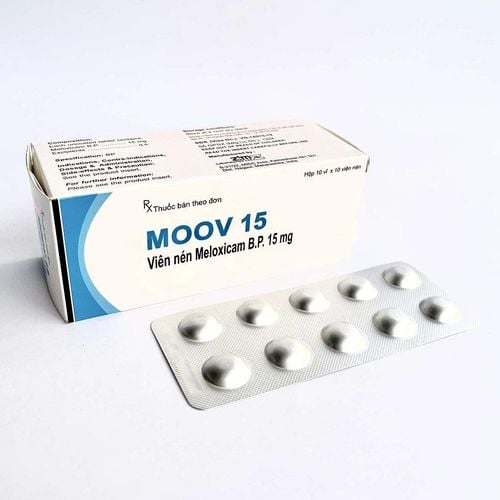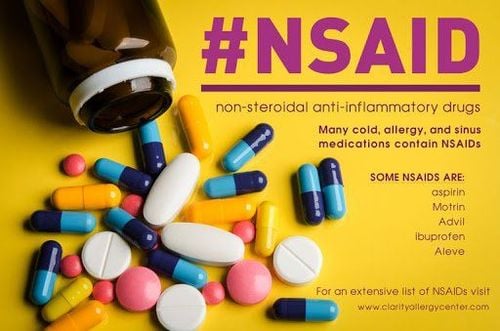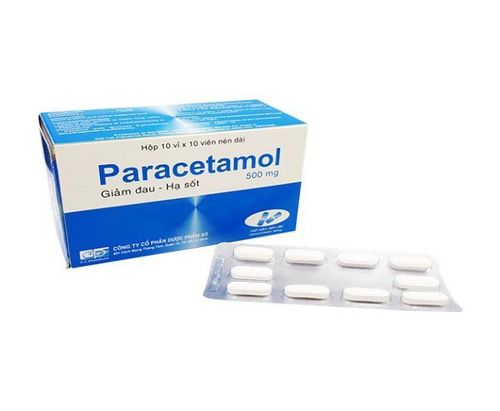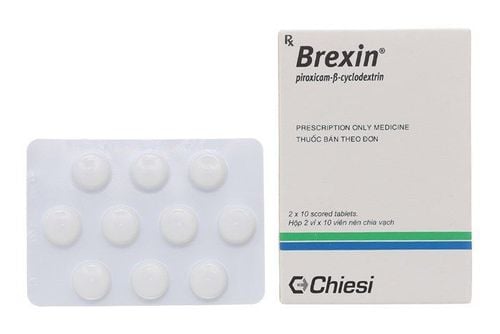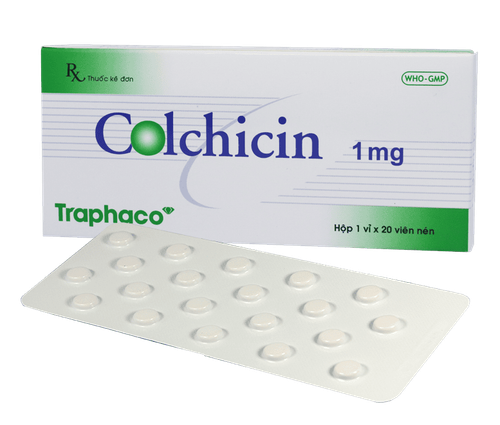This is an automatically translated article.
NSAID group of drugs (NSAIDS) are non-steroidal anti-inflammatory drugs, drugs with analgesic, antipyretic, anti-inflammatory effects, often used to treat diseases related to acute pain and inflammation. musculoskeletal such as: rheumatoid arthritis, gout, juvenile rheumatoid arthritis, osteoarthritis, primary dysmenorrhea,...
1. What drugs are NSAIDs?
NSAID group of drugs (NSAIDS) are non-steroidal anti-inflammatory drugs, drugs with analgesic, antipyretic, anti-inflammatory effects, often used to treat diseases related to bones and joints.
Non-steroidal anti-inflammatory drugs (NSAIDs) are divided into 2 groups, which are:
Non-steroidal anti-inflammatory drugs such as: Aspirin, Ibuprofen. Non-steroidal anti-inflammatory drugs when used should be prescribed such as: Diclofenac, Meloxicam, Flurbiprofen, ....
2. Effects of the NSAID group
Non-steroidal anti-inflammatory drugs have analgesic, antipyretic, anti-inflammatory effects due to the mechanism of action by blocking prostaglandins - these are substances that increase the sensitivity of the nerves and increase your pain in the body. inflammatory process. Prostaglandins also play a role in controlling body temperature.
Non-steroidal anti-inflammatory drugs are indicated for use in the following specific cases:
Patients with inflammatory arthritis such as: Rheumatoid arthritis, ankylosing spondylitis, acute rheumatism, juvenile rheumatoid arthritis adolescents Gout Cervical and lumbar spondylosis, osteoarthritis, shoulder pain, low back pain, sciatica Systemic lupus erythematosus, systemic scleroderma and other systemic diseases. Shoulder periarthritis, humeral humerus, carpal tunnel syndrome and other rheumatic soft conditions. Primary dysmenorrhea In addition, non-steroidal anti-inflammatory drugs are also indicated in some other cases when prescribed by a doctor.
3. Contraindications of Non-Steroidal Anti-Inflammatory Drugs
Patients with a history of allergy or hypersensitivity to any component of non-steroidal anti-inflammatory drugs. gastrointestinal bleeding. Patients with severe renal failure, liver failure, severe heart failure. Patients with uncontrolled bleeding disease Women who are pregnant in the first or third months of pregnancy, women who are breastfeeding.
4. Maximum dosage and duration of use with non-steroidal anti-inflammatory drugs
Non-steroidal anti-inflammatory drugs are used as prescribed by the doctor. You can refer to the dosage of non-steroidal anti-inflammatory drugs as follows:
For the group of non-prescription non-steroidal anti-inflammatory drugs: - Used to reduce fever: The recommended duration of use is not more than 3 days
- Used to reduce pain: Recommended duration of use is no more than 5 days
For prescription non-steroidal anti-inflammatory drugs There is no recommendation on the maximum duration of use for each active ingredient. Depending on the severity of the disease, the doctor will assess the response to the drug and make appropriate indications. It is recommended to use the drug at the lowest dose for the shortest time for the best effect. You can refer to the dosage of non-steroidal anti-inflammatory drugs as follows:
- Dosage for adults:
Celecoxib: use a starting dose of 100-200mg/day divided into 1-2 times/day then increase the dose Depending on the diagnosis and disease response, the maximum dose should not exceed 400mg/day, the maximum duration of use should not exceed 1 week in case of acute pain
Diclofenac diethylamine: topical is indicated in In case of acute bone and joint pain, the dose is 2-4g/day applied 2-3 times/day. Maximum use time is not more than 1 week.
Diclofenac potassium: use a dose of 100mg / day, the maximum duration of use is not more than 1 week. In case of primary dysmenorrhea patients use 200mg/day first, then reduce dose 100mg/day from 2nd to 7th day.
Diclofenac sodium: use dose 100mg/day. Use the lowest effective dose for the shortest possible time to prevent cardiovascular complications.
Etodolac drug: use a dose of 200-300mg x 2 times/day. The maximum dose should not exceed 1000mg / day
Flurbiprofen: Use a dose of 200mg / day divided into 2-3 times. The maximum dose used should not exceed 300mg/day during acute exacerbations.
Ibuprofen: use 1200mg / day divided every 4-6 hours / time. Intravenous solution is made according to the doctor's order.
Indomethacin: Use a maximum dose of not more than 200mg / day and stop the drug after a few days of control of symptoms.
Meloxicam: The starting dose is 7.5mg/day, the usual maintenance dose is 7.5-15mg/day. The maximum dose should not exceed 15 mg/day.
- Dosage for children:
Ibuprofen: use a dose of 5-10mg/kg body weight every 6-8 hours (if needed) in case of pain relief and fever reduction. The maximum dose should not exceed 40mg/kg body weight/day. Indomethacin: Used to treat juvenile rheumatoid arthritis. Initial dose is 1-2mg/kg body weight/day, maintenance dose is 2-4mg/kg body weight/day. The maximum dose should not exceed 4mg/kg body weight/day or 150-200mg/day.
Naproxen: Dosage 10mg/kg body weight/day divided into 2 times used in the treatment of juvenile rheumatoid arthritis.
Naproxen sodium: used to treat headaches in children, used orally, the dose is 5-7mg/kg body weight/time, 8-12 hours apart. Contraindicated for children 2 years of age and younger.
5. Side effects of Non-Steroidal Anti-Inflammatory Drugs
Non-steroidal anti-inflammatory drugs can cause unwanted effects. Common side effects of non-steroidal anti-inflammatory drugs include:
Headache, dizziness, dizziness Abdominal pain, bloating, indigestion, loss of appetite, nausea, vomiting. Urticaria Anaphylaxis Jaundice, increased transaminases, increased liver toxicity Chest pain, heart failure, palpitations, palpitations, myocardial infarction. Risk of stomach ulcers Gastrointestinal bleeding
6. Use caution when using non-steroidal anti-inflammatory drugs
Use Non-Steroidal Anti-Inflammatory Drugs at the lowest daily dose to be effective in the shortest possible time to minimize the risk of unwanted side effects of the drug Use caution when using Non-steroidal anti-inflammatory drugs steroids in patients with asthma, seasonal allergic rhinitis, COPD, hypertension, diabetes, patients over 65 years of age. The patient has an active infection with a history of peptic ulcer disease. Patients with cardiovascular disease or risk factors for cardiovascular disease.
7. Non-Steroidal Anti-Inflammatory Drug Interactions
Non-steroidal anti-inflammatory drugs may interact with the following drugs:
When used concurrently with Digoxin, diclofenac may increase blood levels of digoxin. Increased risk of bleeding when used with anticoagulants and antiplatelet agents. Other non-steroidal anti-inflammatory and corticosteroids Antihypertensives such as beta-blockers, angiotensin-converting enzyme inhibitors. The drug increases toxicity on the liver, so during the use of non-steroidal anti-inflammatory drugs, the patient should not use alcohol, beer and other alcoholic beverages. Group of diuretics Store non-steroidal anti-inflammatory drugs at room temperature, in a cool, dry place, away from light and reach of children.
Above is all the important information about non-steroidal anti-inflammatory drugs. You can refer to more about the use of drugs to be effective and safe for health.
Please dial HOTLINE for more information or register for an appointment HERE. Download MyVinmec app to make appointments faster and to manage your bookings easily.




